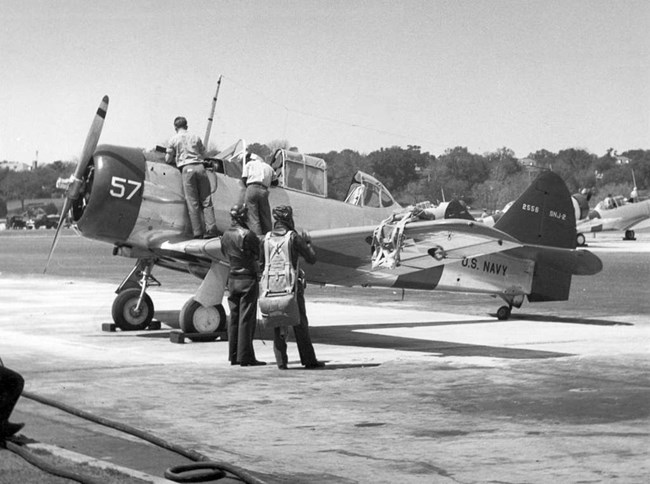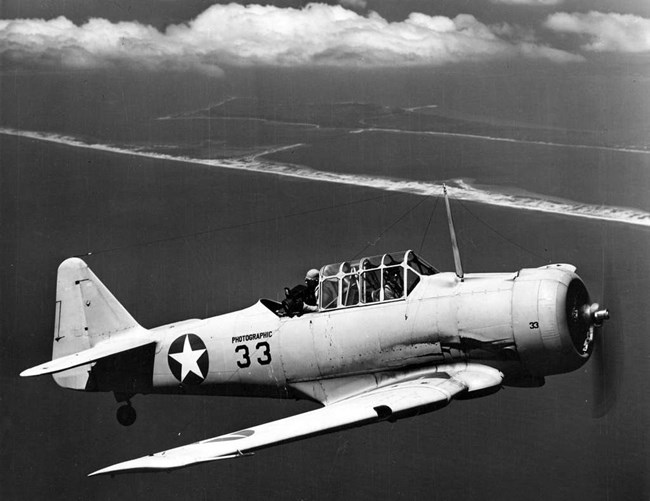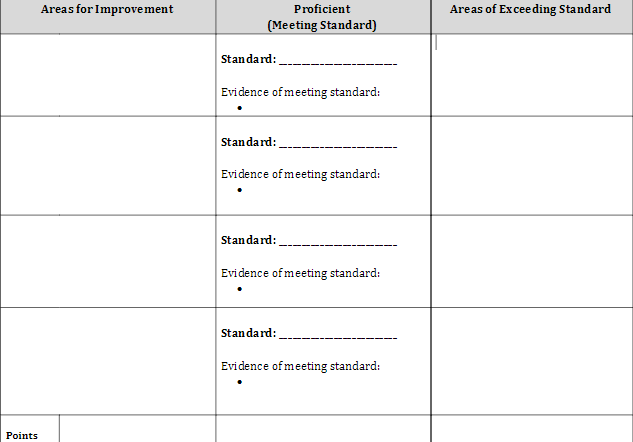Part of a series of articles titled Pensacola and Escambia County, FL, WWII Heritage City Lessons.
Article
(H)our History Lesson: Pensacola and Escambia County, Florida: Comparing and Connecting WWII Home Front cities

Credit: U.S. Navy National Museum of Naval Aviation
About this Lesson
This lesson is part of a series teaching about the World War II home front, with Pensacola and Escambia County, Florida designated as an American World War II Heritage City. The lesson contains photographs, two readings, optional documentary extension, and a culminating mastery project. The first reading describes the military readiness of the area, and the second connects the region to the designation of a Heritage City. The culminating project contributes to learners’ understandings of the city as a WWII Heritage City, with the opportunity to combine lesson themes from the three other lessons in the Pensacola and Escambia County lesson collection. This is to summarize the city’s contributions and encourage connections to the overall U.S. home front efforts.
Objectives:
In a culminating product:
-
Identify important World War II home front locations in Pensacola and Escambia County, Florida and describe their historical significance
-
Summarize the contributions of diverse Pensacola and Escambia County civilians and service members to home front wartime efforts
-
Evaluate the challenges, and contributions, of African American service members in Pensacola and Escambia County
-
Optional: Describe similarities and differences of Pensacola and Escambia County and other Heritage city(s) / World War II home front(s).
Materials for Students:
- Photos 1 – 4
- Readings 1, 2
- Maps, project materials (as needed)
- Student graphic organizers (See photo 5 at end of lesson, for reference)
- Create Comparison Matrices for your students to use. To compare two cities, create a one-page sheet with three columns and four rows. Label the left column Theme/Topic and the other columns City 1 and City 2. For a Comparison Matrix for three cities simply add an additional column.
- Create two Single-Point Rubrics to assist students’ self-assessment. One is for assessing proficiency in meeting teacher-selected standards. One is for assessing proficiency in meeting objectives.
- For the rubric on standards, create a one-page sheet with three columns and four rows of content. Label the first column “Areas for Improvement,” the second column, “Proficient (Meeting Standard),” and the third column, “Areas of Exceeding Standard.” Leave the first and third columns blank. In each row of the second column identify a Standard and indicate a space for noting the evidence for meeting the standard. Include a space at the bottom of the page for assigning points for each column.
- For the rubric on objectives, create a one-page sheet with three columns and four rows of content. Label the first column “Areas for Improving toward Objective,” the second column, “Proficient (Meeting Objective),” and the third column, “Areas of Exceeding Objective.” Leave the first and third columns blank. In the four rows of the second column identify these four objectives:
- Identify important World War II home front locations in Pensacola and Escambia County, Florida and describe their historical significance
- Summarize the contributions of diverse Pensacola and Escambia County civilians and service members to home front wartime efforts
- Evaluate the challenges, and contributions, of African American service members in Pensacola and Escambia County
- Optional: Describe similarities and differences of Pensacola and Escambia County and other Heritage city(s) / World War II home front(s).
Include a space at the bottom of the page for assigning points for each column. See the last photo of this lesson for reference.
Getting Started: Essential Question
Why was Pensacola and Escambia County chosen as an American World War II Heritage City, and what are its similarities and differences to other home front cities?
Aerial Views of Pensacola


Left image
Photo 1: “Aerial View of Pensacola, Navy Planes over Pensacola, Fla.” Vintage postcard
Credit: Credit: Boston Public Library
Right image
Photo 2: Aerial photo of Naval Air Station Pensacola, February 15, 1943
Credit: Credit: U.S. Navy Naval Aviation News
Quotation to consider:
“It was here, at Naval Air Station Pensacola, where aviators were trained that pioneered the tactics and techniques that grew Naval Aviation from a fledgling force of sea planes to the mighty carrier strike forces of World War II.” - Captain Timothy Kinsella
(Source: “Battle of Midway Remembered: NAS Pensacola Played Important Role,” DVIDS, June 6, 2019)
Read to Connect
Reporter Discovers Fort Pickens Gives Section Formidable Defense
By Bill Middlebrooks
Pensacola News Journal, April 6, 1942 (p.15)
Should the ‘barber shop general’ tell your Fort Barrancas and Fort Pickens hold no protection for this area, cooly by firmly request the ‘general’ to ‘tell it to the Marines’ and dismiss the alarmist with a wave of the hand.
I know whereof I speak. I spent several hours in Barrancas and Pickens with a fellow reporter and while our guide, Capt. Charles G. Pirkle, did not show us all, we saw enough to realize there is little to worry about should the enemy become ambitious and attack Pensacola and her harbor defenses.
From a wharf at Fort Barrancas, an active, well-equipped, well-manned and attractive post which nobly guards the entrance to Pensacola bay, our party boarded the valiant tug Regal and within a span of minutes crossed the mile and a half bay and docked at Santa Rosa island – site of historic Fort Pickens.
Pickens—famous for its successful defense during the War Between the States—scowls out across the snow-white sand dunes of the island, kissed on one side by the gulf and on the other by the bay, and stirs with the excitement of a new war. Overhead, giant naval flying boats are forever droning their huge motors while Coast Artillerymen stand patient vigilance at their heavily camouflaged guns, which safeguard democracy and the American way of life. All of this—and more, too—belongs to the wartime setup of teeming activity of the Harbor Defenses of Pensacola.
Santa Rosa island is a long and narrow strip of sand dunes and salt marshes, never more than 500 yards wide and stretching for 42 miles among the gulf coast, rises majestically out of the salty sea. When disembarking from the ferryboat, one would least suspect it is an ‘arsenal of democracy.’ But the guns are there, so well camouflaged that even naval aviators who have been flying over the island for months cannot detect them.
After meeting Sergt. C. E. Sprinkle, the ‘Mayor of Pickens,’ (He’s been caretaker of the post many years) we climbed into a jeep. Down the white and glistening beach tore our powerful little vehicle, now and then cutting across the island speeding down the hardpacked beach and then rolling over the lofty dunes which slowed, but never stymied the four-cylinder machine. We roared past old Pickens covered with beach ivy over the dunes again and along-side the sparkling sea, finally pulled up to a camouflaged position manned by a mixture of selectees and enlisted men—young, eager, alert and husky from rugged life on the sun-baked island.
‘These men are a little nervous,’ the captain said as we walk up to their station. ‘Being on the alert all the time creates a little tension.’ The men, clad in fatigue clothes and donning steel helmets, sat at their stations playing cards—ready to fire on a moment’s notice. The men off duty sleep near their assigned post, their cots and bunks draped with netting to shield them from mosquitoes.
Guns, concrete, sandbags, camouflage, command post, plotting room, and tents for the artillerymen—all of this is to be found on Santa Rosa island, commanded by Col. A. V. Rinearson of the 13th Coast Artillery regiment.
On the day that war was declared artillerymen moved over from tidy Barrancas and they’ve been living in their pyramidal tents ever since. They’ve been working and working since that eventful day of December 7, 1941, and everything is in readiness should the enemy put in an appearance.
The camouflaging of the guns is a neat job and credit of the task goes to 2nd Lt. Richard B. Olney, a native of Charleston, S. C., and graduate of the Citadel, who is handling the project ‘in addition to other duties.’
Lieutenant Olney, a sandy-haired chap of 24 years with 15 years military training in prep schools and colleges, is quite wrapped up in camouflaging and spends most of his spare time work(ing) out problems to fool the enemy. And from the ‘before and after’ aerial photographs shown the writer. I’m bewildered after having visited the actual location of the work.
‘It’s hard to tell you about and you can only convey the idea and problems of camouflaging by photographs,’ the lieutenant said ‘There’s no set methods used to camouflage and each sector presents an entirely different problem. Santa Rosa island holds nearly every problem for concealment.’
Lieutenant Olney has done a commendable work in concealment. The commanding general of the Southern Sector, General Blood, visited Pickens and after the trip said it ‘is the best job I’ve seen.’ But Olney modestly gives credit to men and non-commissioned officers working under him. ‘The men have taken a decided interest in the project and we all have a hand and offer suggestions.’
He points out that co-operation by the Naval Air station has had much to do in the success of Picken’s camouflaging. The lieutenant is often forced to ask the Navy to aid him. ‘We have 100 per cent co-operation by the Navy, more than we should, I guess.’ Olney and the Naval Air station camouflage officer work together like brother officers and often solve each other’s problems. ‘It just comes to us some way and when we get an idea we’ll exchange them.’
Excerpt from: “House Report 115-998, “To Direct the Secretary of the Interior to Annually Designate at Least One City in The United States as An ‘American World War II Heritage City,’ and for other purposes” (October 30, 2018)
“. . .PURPOSE OF THE BILL
The purpose of H.R. 6118 is to direct the Secretary of the Interior to annually designate at least one city in the United States as an ``American World War II Heritage City''.
BACKGROUND AND NEED FOR LEGISLATION
On December 7, 1941, military forces of the Empire of Japan attacked the U.S. Naval Fleet and ground bases at Pearl Harbor in Hawaii. On December 8, 1941, one day after what President Roosevelt referred to as, ``a date which will live in infamy,'' the United States declared war against the Empire of Japan. Three days later, on December 11, 1941, Japan's ally, Germany, declared war on the United States. Sixteen million Americans, mostly young working-age men, served in the military during World War II, out of an overall United States population of 113 million.
While an unprecedented number of Americans served in World War II, the country drastically increased its war production on the home front, serving not only the needs of the armed forces of the United States but her allies as well--in what President Franklin Roosevelt called ``The Arsenal of Democracy.'' The combination of millions serving in the military, during a period of necessary and drastic increases in production, led to significant social changes on the American home front.
The World War II period resulted in the largest number of people migrating within the United States in the history of the country. Individuals and families relocated to industrial centers for good paying jobs out of a sense of patriotic duty. Many industrial centers became ``boomtowns,'' growing at phenomenal rates. One example, the City of Richmond, California, grew from a population of under 24,000 to over 100,000 during the war. . . .”

Credit: U.S. Navy National Museum of Naval Aviation
Student Activities:
Questions for Reading 1
- Which details in the author’s writing help you visualize the land and geographic features of Pensacola Bay and area surrounding the forts?
- What was the purpose of camouflaging the forts?
- Why was this area ideal for developing military installations, both before and during World War II?
- Reflect on this sentence: “Olney and the Naval Air station camouflage officer work together like brother officers and often solve each other’s problems.” Then answer the following questions:
- Why was cooperation across installations important across Pensacola and Escambia County?
- How did military service members, but also civilians, work together to contribute to the war efforts from the home front?
Questions for Reading 2, Photos
-
What was the purpose of the bill (H.R. 6118) according to the report?
-
Why do you think Pensacola and Escambia County, Florida was designated as a World War II Heritage City? Use details from the bill and from the lesson(s) information.
-
Are there other cities you think of when considering home front contributions during wartime? Which, and why?

Courtesy of Sarah Nestor Lane
Culminating Activity/Mastery Product
To demonstrate student understanding, support students in creating a final product that meets the following objectives:
-
Identify important World War II home front locations in Pensacola and Escambia County, Florida and describe their historical significance
-
Summarize the contributions of diverse Pensacola and Escambia County civilians and service members to home front wartime efforts
-
Evaluate the challenges, and contributions, of African American service members in Pensacola and Escambia County
-
Optional: Describe similarities and differences of Pensacola and Escambia County and other Heritage city(s) / World War II home front(s).
Mastery products should be:
. . . student-led; Students work as individuals or in collaborative groups.
. . . student-directed; Students are offered a variety of choices for product type.
. . . student-organized; Teacher facilitates by providing students with the comparison matrices and/or resource links from throughout the series of lessons.
. . . student-assessed; Teacher supports student self-assessment and reflection by providing students single-point rubrics to assess for meeting standards and/or lesson objectives.
Note: Depending on time and scope, the comparison of Pensacola and Escambia County to another WWII Heritage city(s) within the mastery product (objectives) may be omitted. However, comparing cities is recommended, as it connects students to a deeper understanding of the WWII home front.
Examples of mastery product choices include, but are not limited to:
-
Written: Letter (opinion or informative), essay, poem, narratives, biography, articles, class book or children’s book, speech or debate (then presented orally), blog / website, plaque or historical displays, pamphlets or rack cards
-
Graphic Organizers: timeline, flowcharts, mind or concept content maps, Venn diagrams, comparison matrices, posters
-
Artistic Expression: song, dance, theater (ex. skits), 3-D models, dioramas, photo journal, stamp and coin designs, visual art, architecture/building or monument, museum design
-
Media design and creation: podcast, historical markers, social media content, interactive virtual maps or tours, infographics, video, comic strips or graphics, game design, slideshows, digital scrapbook
Please view Teaching with Historic Places: World War II for information and resources on other cities.
This lesson was written by Sarah Nestor Lane, an educator and consultant with the Cultural Resources Office of Interpretation and Education, funded by the National Council on Public History's cooperative agreement with the National Park Service.
Tags
- world war ii
- wwii
- world war 2
- ww2
- world war ii home front
- world war ii mobilization
- wwii home front
- american world war ii heritage city program
- awwiihc
- teaching with historic places
- twhp
- twhplp
- hour history lessons
- pensacola
- naval air station pensacola
- escambia county
- florida
- aviation history
- military and wartime history
- women in world war ii
- african americans in wwii
- civic engagement
Last updated: July 3, 2024
